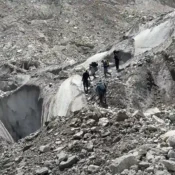Vasukital Trek – Beauty and the Beast – 2025

Vasukital Trek – Beauty and the Beast – 2025
Gangotri – Tapovan – Nandanvan – Vasukital
Anurag Goyal, 22-28 June 2025
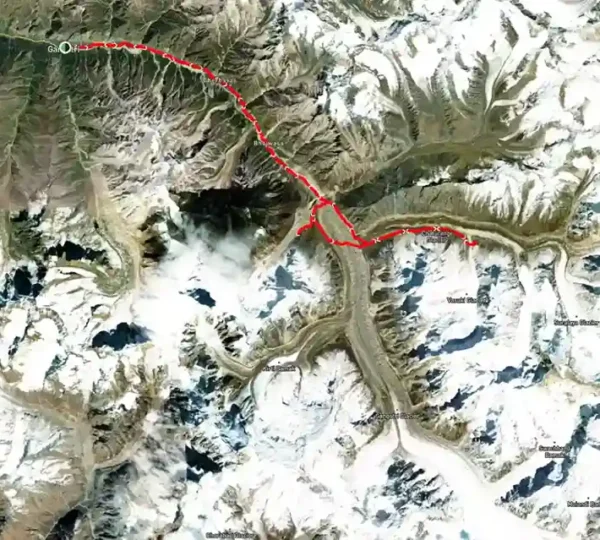
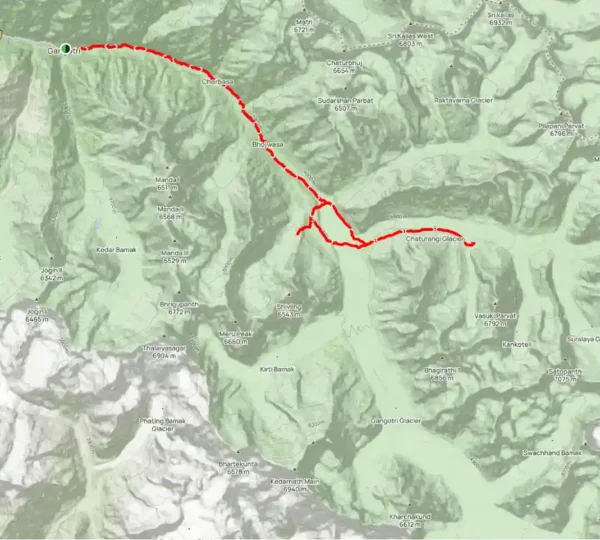
The journey of Vasukital trek begins at Gangotri Dham, one of the four sacred shrines of the Chhota Char Dham Yatra. Pilgrims from across India come here to seek blessings at the Ganga temple, believed to be the earthly origin of Goddess Ganga. Before setting off, it’s customary—and spiritually grounding—to take a ritual bath in the icy waters of the Bhagirathi River and witness the evening aarti at the temple. The atmosphere is calming and powerful—a perfect way to begin a journey that will demand both mental and physical fortitude.
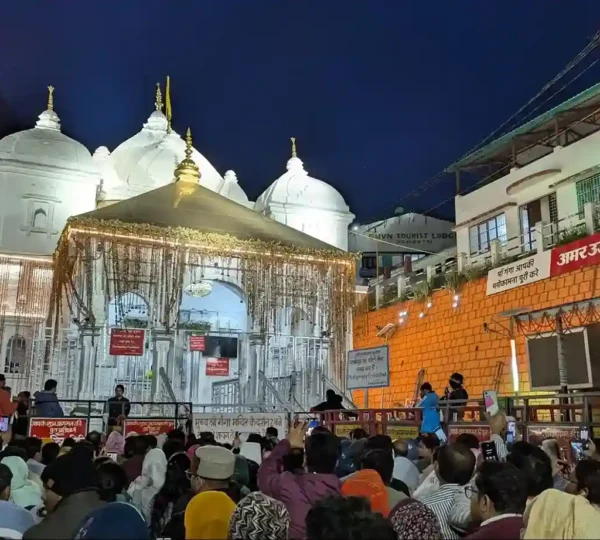
Day 1: Gangotri (3086m) to Bhojwasa (3785m) – 15km
We set off from Gangotri early, following the Bhagirathi River upstream. The trail is straightforward today. If lucky, you can spot peaks such as Mt. Sudarshan and Manda I, II, III peaks and Thalay Sagar.
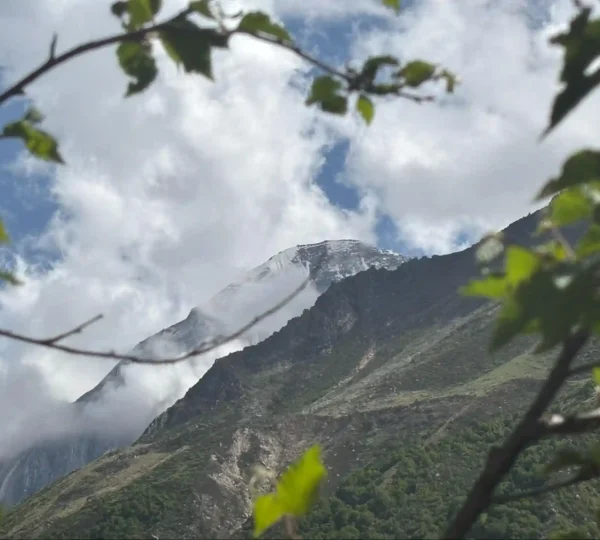
(Mt. Thalay Sagar)
More than halfway through, you will enter a rockfall-prone zone, where vigilance is critical. Wildlife movement and winds can easily dislodge rocks from the fragile hillsides. Our guide laid down a strict protocol—move fast, stay alert, and cross one by one.
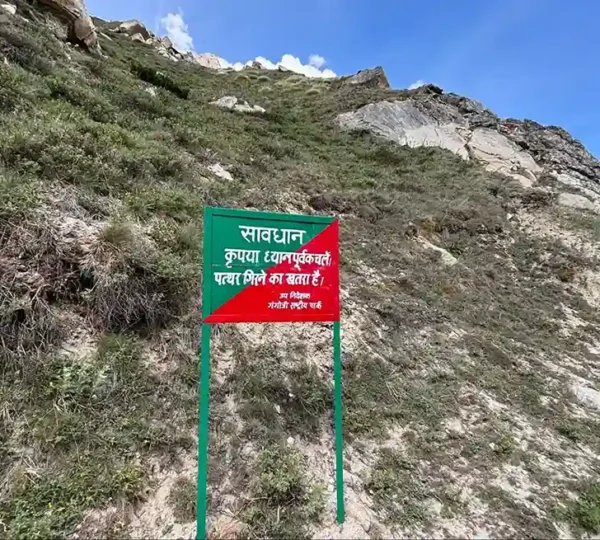
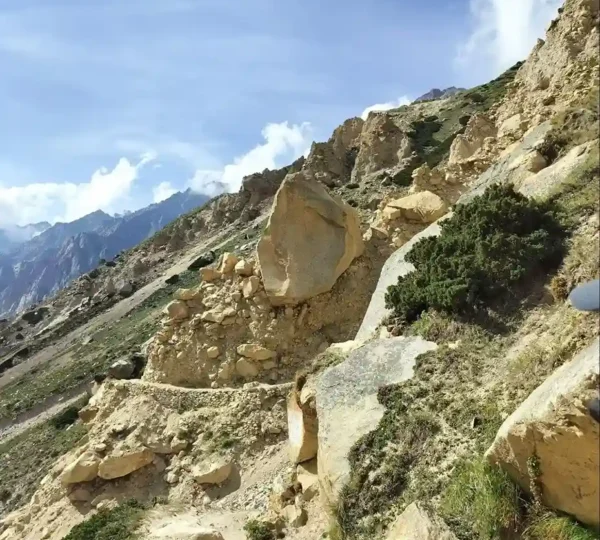
Along the way, we were lucky to spot our first Bharal (Himalayan blue sheep) grazing on the slopes.
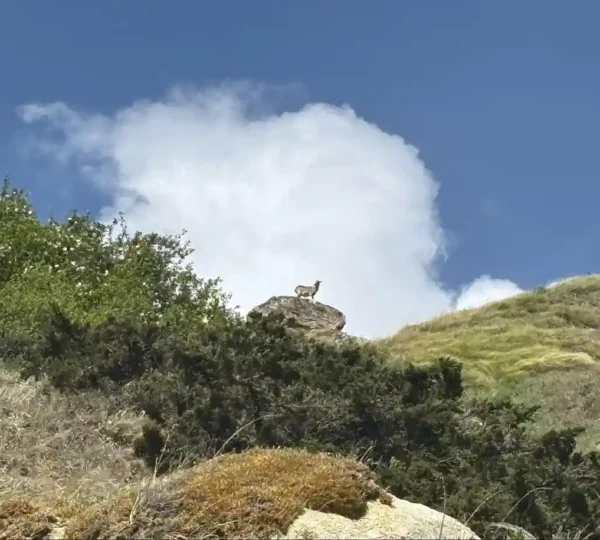
Finally, we reached Bhojwasa, a windswept plain offering the first clear view of the Bhagirathi peaks.
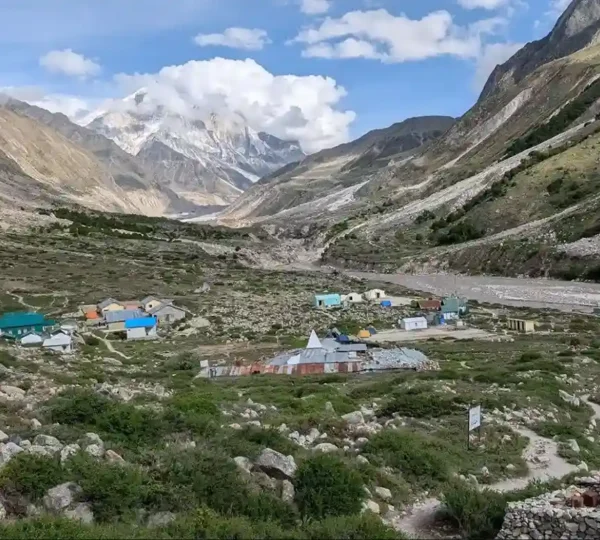
Day 2: Bhojwasa to Tapovan (4316m) – 6km
We started the day early from Bhojwasa, proceeding to what’s considered the first major challenge of the trek. The route begins with a trolley crossing over the Bhagirathi River—a manual cable cart operated with ropes that gets you across the fast-flowing current. It’s efficient, but also a good reminder that we were now stepping out of our comfort zone.
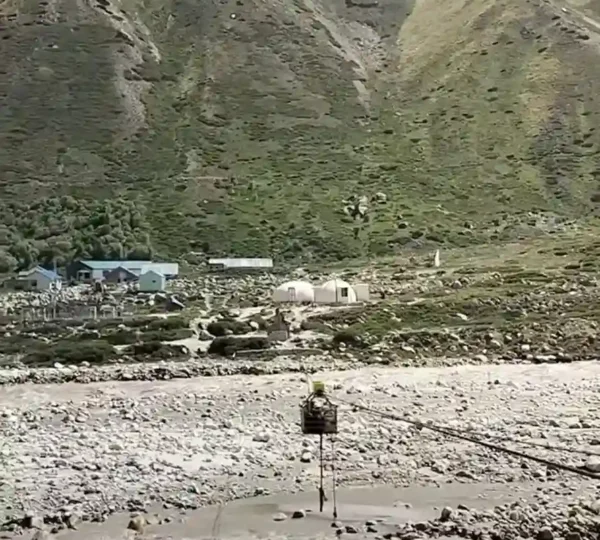
After the crossing, the trail follows the Bhagirathi upstream. The river gradually narrows, and the path becomes rougher. After a while, you can descend into the glacial basin. But here, you have to cross multiple glacial streams, often by balancing on loose boulders and slippery rocks. Trekking poles and good timing are essential—many of these streams swell quickly in daylight.

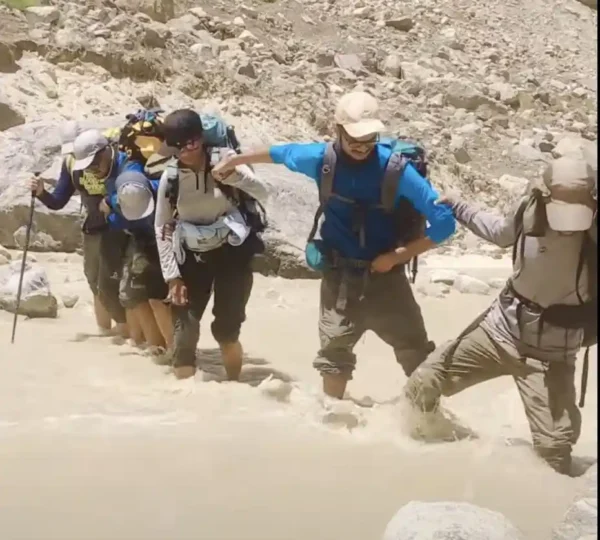
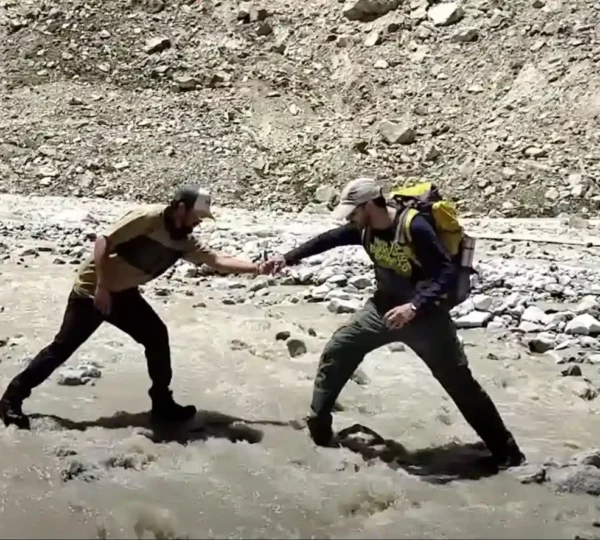
Soon, we reached Gomukh, the snout of the Gangotri Glacier, where the Bhagirathi River emerges from a cavernous mouth of ice. It’s a powerful sight and a sacred one—but our guide planned for us to visit Gomukh on the return leg, so we continued the climb towards Tapovan.
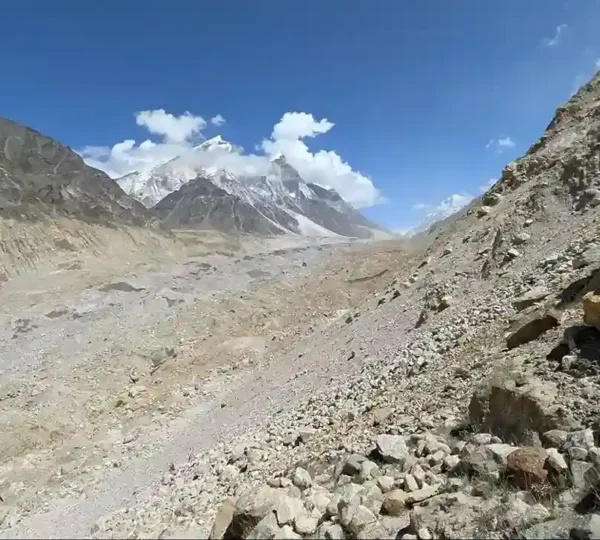
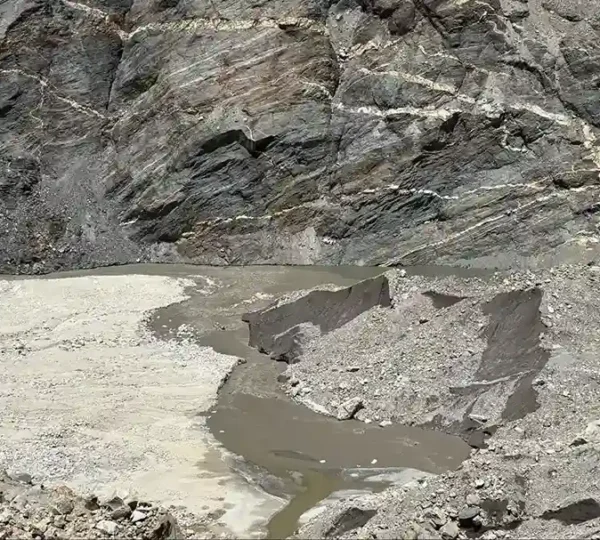
(1 – Ascending to Tapovan, 2 – Gomukh seen from above)
From here, the route becomes typical. The ascent involves negotiating a steep, ever-changing trail over the Gangotri Glacier, filled with moraines, loose scree, and crevassed terrain. Our guides were clear: this is where attention becomes non-negotiable. Even a momentary lapse in focus can result in a fall, injury, or worse.
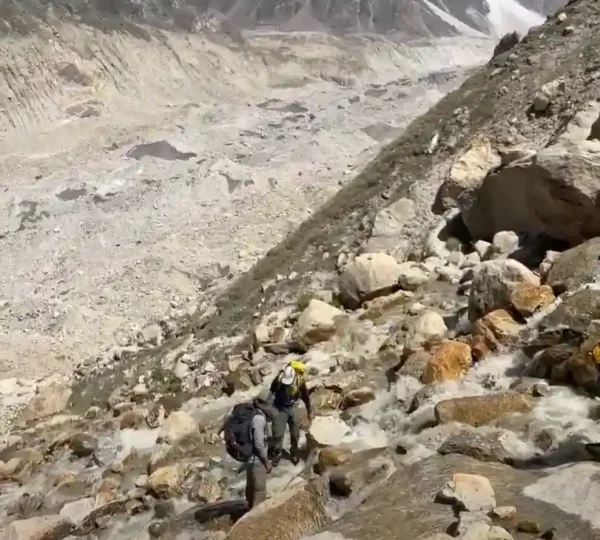
(Amrit Ganga falling from Tapovan)
After a final push through boulders and slippery switchbacks, we emerged into Tapovan—a high-altitude meadow perched dramatically beneath the vertical rise of Mount Shivling. Few places are as strikingly placed in the Himalayas. Shivling dominates the southern skyline like a granite cathedral, while Bhagirathi II,III,I stands tall to the east.
In Sanskrit, Tapovan means “forest of penance”, and mythology holds that this very place was once a meditative retreat for ancient sages. It’s said that Sage Tapasvi and later Sage Bhagirath performed deep austerities here to please Lord Shiva and bring the celestial river Ganga down to Earth.
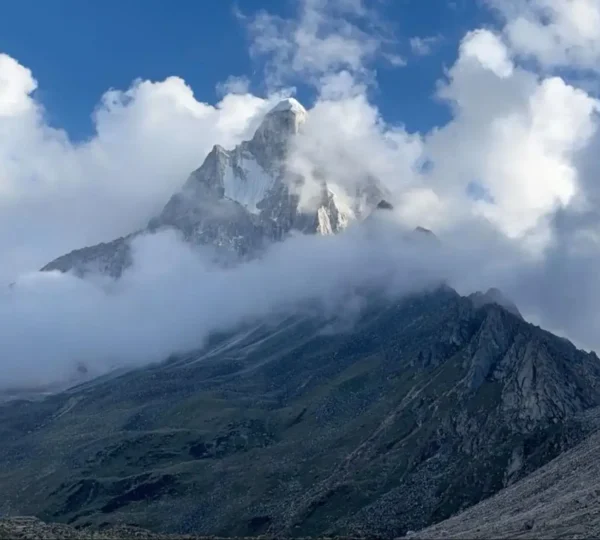
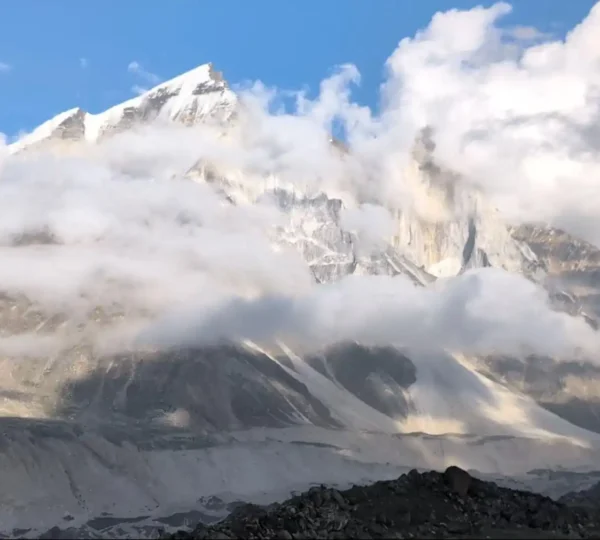
The exhaustion of the day melted slightly in the calm evening light. This was not a beginner’s trail. But with guidance, humility, and caution, we made it through.
Day 3: Tapovan to Meru Glacier (4570m) and back – 5km
This was an acclimatization day with a short hike towards the Meru Glacier. But even a 5 km stretch here can sap your energy. The trail involved careful moraine negotiation, with no fixed route. The “Shark’s Fin” of Meru looked every bit as intimidating as climbing legends describe it.
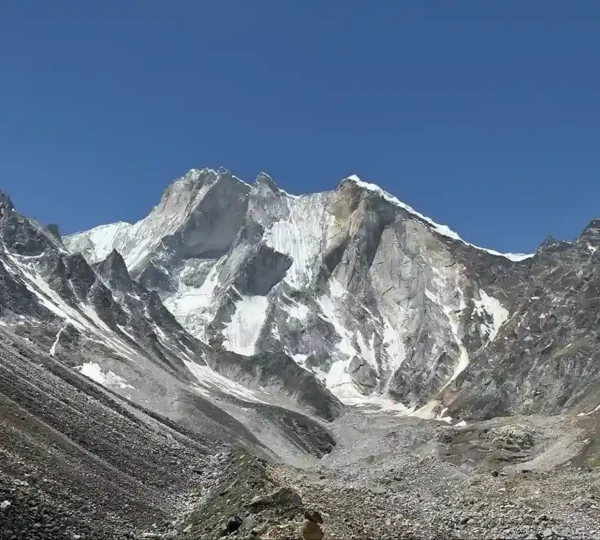
Despite fatigue, these close-up views of Garhwal’s iconic peaks made the effort worthwhile.
Day 4: Tapovan to Nandanvan (4480m) via Gangotri Glacier – 8km
Laterally crossing the Gangotri Glacier, we made our way toward Nandanvan. This was one of the trickiest days of the trek. Moraines gave way to glacier plates. Rocks moved underfoot. The line between trail and hazard was blurry at best.
It was our first time navigating a glacier. Seeing open crevasses and sliding rocks, added to tension. Still, our guides navigated with confidence, and our porters—carrying tents, fuel, and supplies—moved with strength and steadiness that deserves more recognition than it gets.
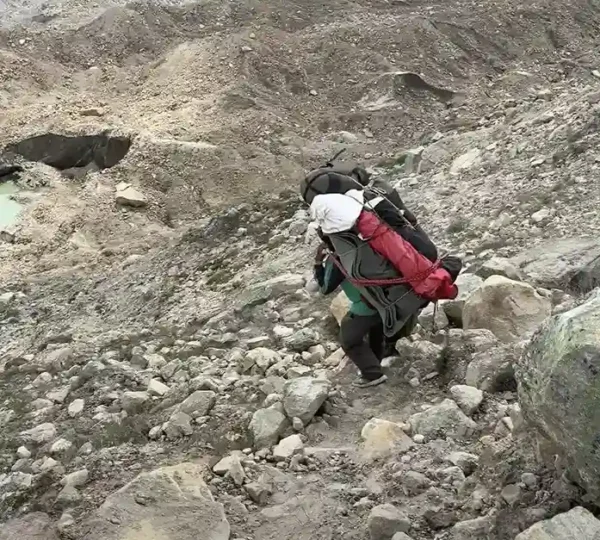
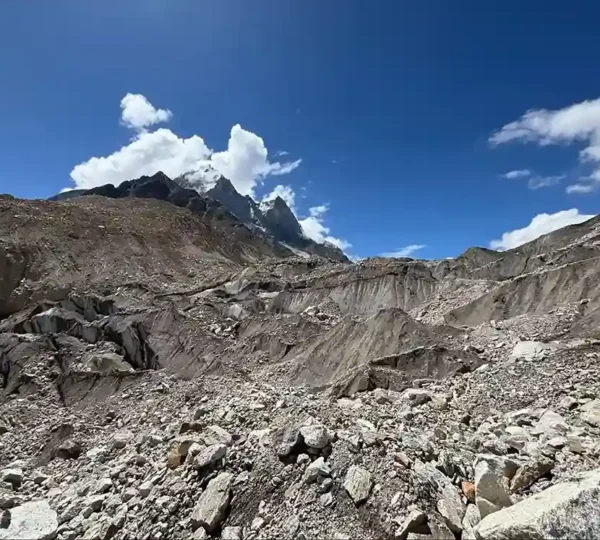
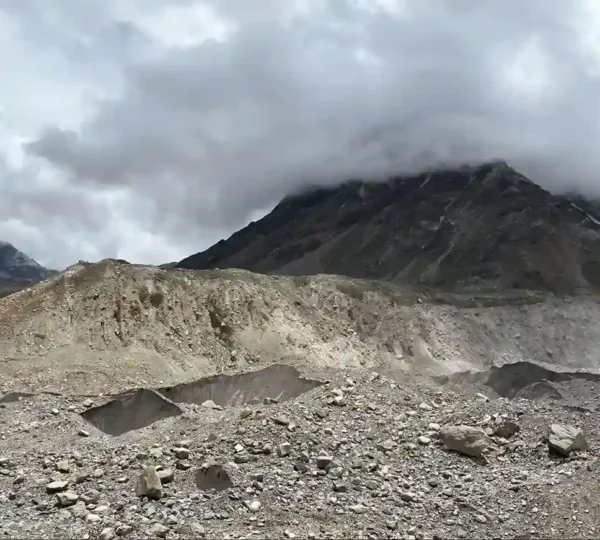
(1 – Porter descending onto the glacier, 2 – Crossing the glacier, 3 – Final climb towards Nandanvan)
Reaching Nandanvan felt like a reward. Though the terrain was barren, the sense of space and scale—ringed by Shivling, and Bhagirathi peaks—was unmatched. We ventured a bit from the campsite to stare at Mt. Kedar Dome and Mt. Kharchakund in awe and silence.

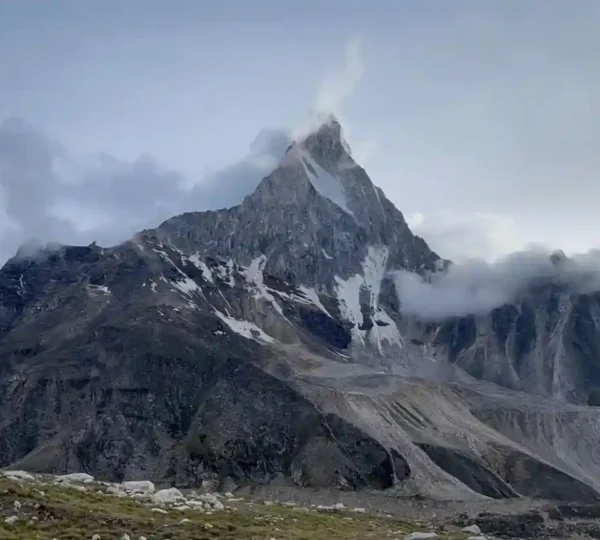
(1 – Mt. Kharchakund, 2 – Mt. Kedar Dome, 3 – Mt. Shivling)
Day 5: Nandanvan to Vasukital (4930m) and back – 14km
This was summit day of Vasukital trek—if you can call a remote glacial lake a summit. For a brief stretch, the trail offers pure visual payoff: the Bhagirathi massif to the south and Vasuki Parvat to the East. This is the base camp zone for Mt. Bhagirathi, where you feel close enough to reach out and touch it.
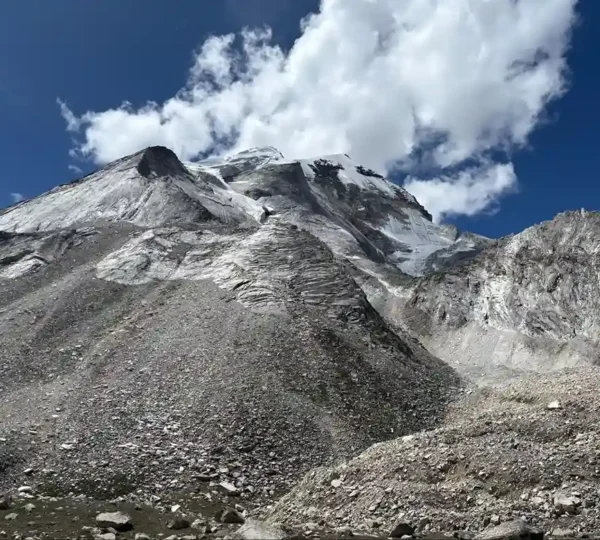
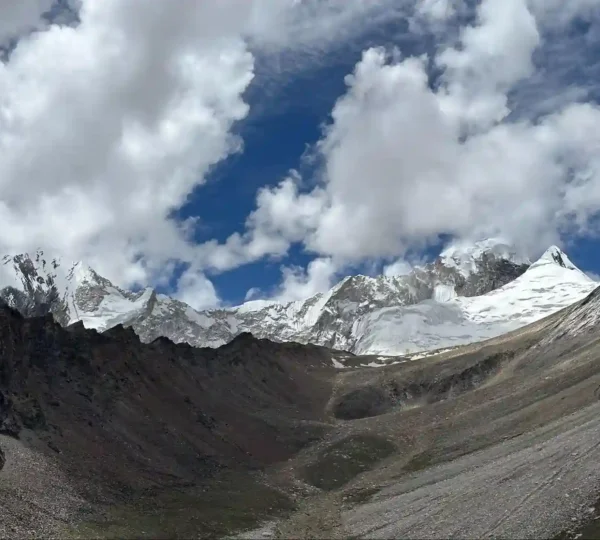
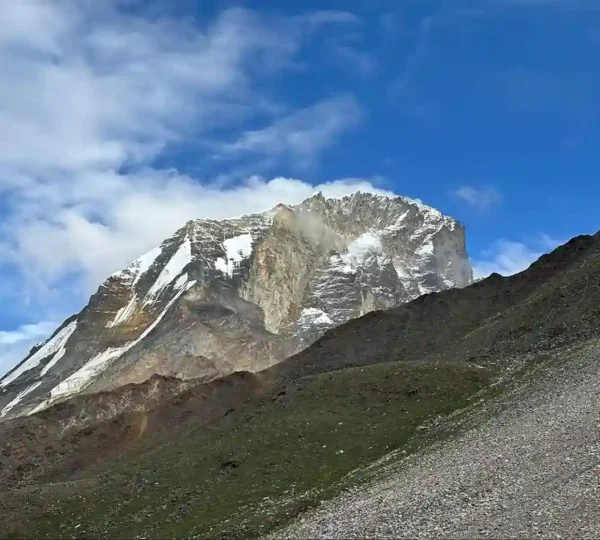
(1 – Mt. Bhagirathi II, 2 – Bhagirathi Massif, 3 – Vasuki Parvat)
As we gained height, looking to the north, we were treated to our first full view of the Chaturangi Glacier—aptly named, as it literally means “four-colored glacier”. In the distance, Mt. Chaturangi (6400m) stood tall.
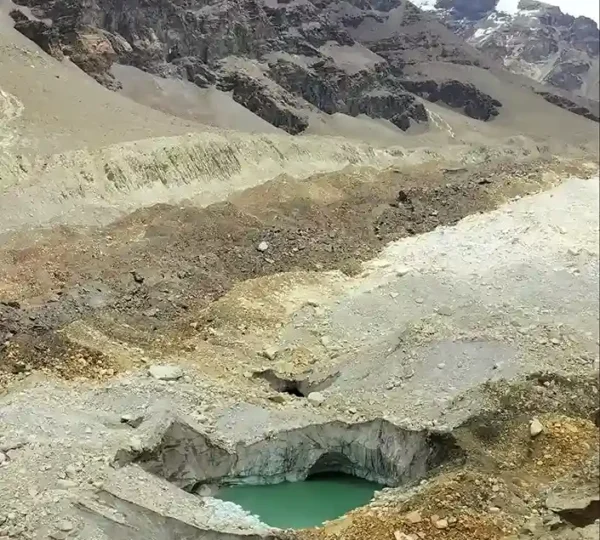
From this point, the trail becomes significantly steeper. The moraine descends sharply between the Bhagirathi massif and Vasuki Parvat, filled with gravel and unconsolidated rock. A fixed rope section had been set up for the final 100 meters of vertical gain. This climb is not technical, but it’s demanding and physically draining—especially above 4900 meters.
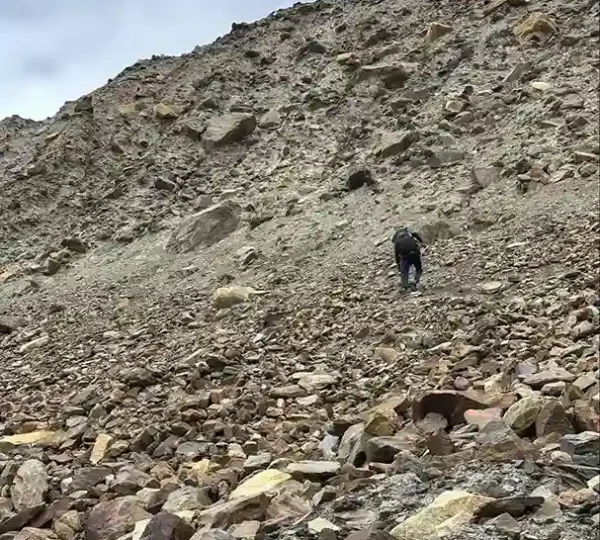
At the top, just as the breath shortens, you step over the final ledge and catch your first glimpse of Vasukital—a still, glacial lake cradled in the bowl beneath Vasuki Parvat (6792m).
There are no words for the silence here. The lake has a cold, pristine quality, almost surreal in its isolation. No meadows, no trees—just rock and water under an infinite sky. It’s not picture-perfect in the traditional sense, but it is profound.
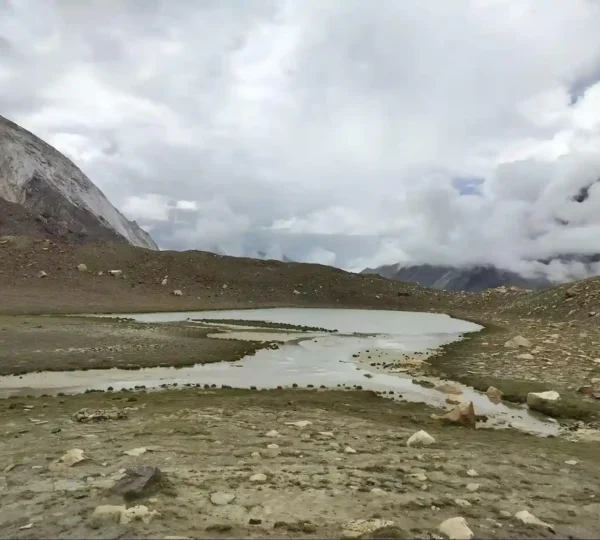
We didn’t spend long. At that altitude and exposure, the weather turns quickly, and the descent via the rope section requires fresh focus. We traced our steps back to Nandanvan, our legs shot and our hearts full of gratitude for the guides who led us safely every step of the way.
Day 6: Nandanvan to Bhojwasa – 10km
Descending from Nandanvan to Bhojwasa meant re-entering the Gangotri Glacier—but unlike Day 4, the route this time was far more treacherous. The descent trail was a steep slope of wet, unstable dirt layered over hard ice, offering almost no grip. Every footstep had to be calculated—slip here, and you’d slide straight into boulders or worse, into open crevasses.
Once we dropped onto the glacier, it became a game of balance and nerve. The crevasses were closer together and more exposed than they had been a few days earlier.
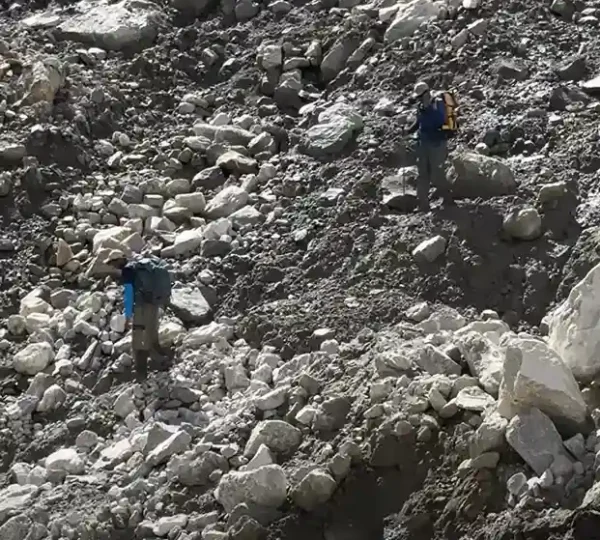
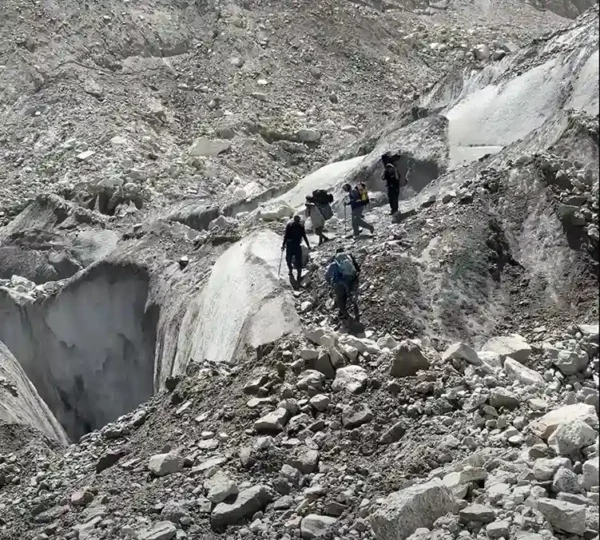
We were constantly walking on boulders, some perched delicately on ice or each other, pivoting under body weight if stepped on wrong. These rocks don’t give warning—they either hold or roll. Every step felt like a question with no guarantee of an answer. The guides led meticulously, often testing rocks ahead or marking alternate lines when gaps between safe footing became too wide.
Once we reached the lower end of the glacier, we arrived at Gomukh, the snout of the Gangotri Glacier—a psychological and spiritual milestone. Unlike our earlier pass, we stopped here to pause and reflect. The Bhagirathi River roared out from the ice, marking the end of the glacial terrain we had been navigating for days. As per tradition, we collected Gangajal, taking a moment of stillness before the final leg.
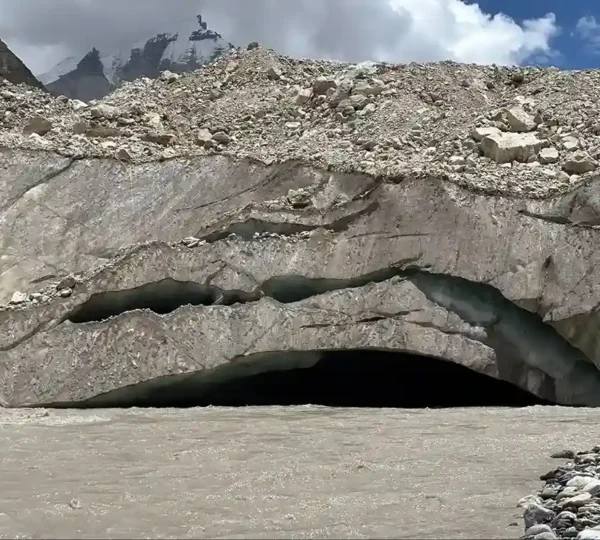
From Gomukh, the trail descended into the basin, but the swollen glacial streams had overrun the usual path. Our guides stepped into the water, building makeshift crossings by dropping rocks into the current—crafting a way forward where none existed. Without their expertise, progress would’ve stopped entirely.
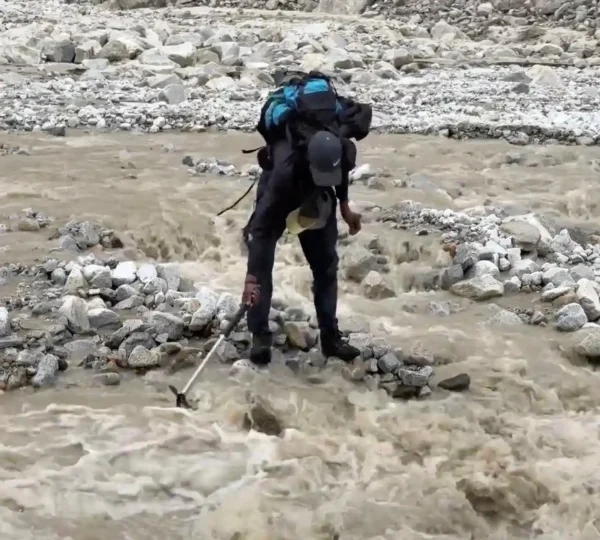
Eventually, we reached the Bhagirathi trolley crossing and Bhojwasa lied at the other end.
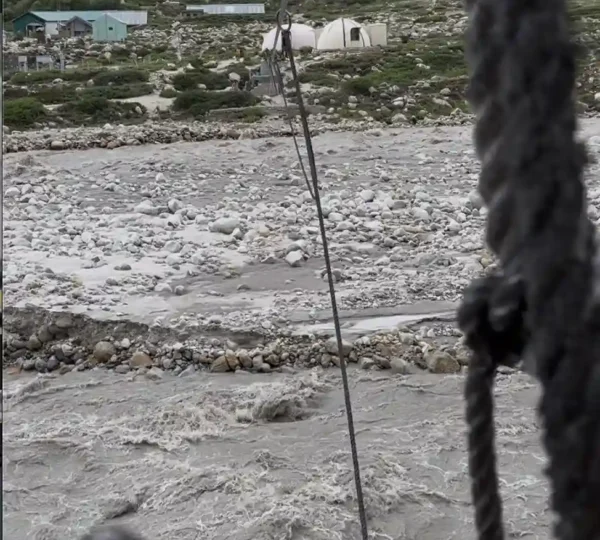
Day 7: Bhojwasa to Gangotri – 15km
The final leg to Gangotri was straightforward but long. Yet there was a quiet satisfaction. I was sore, sure—but also immensely grateful. Grateful for the experience, for the people I shared it with, and especially for the guides and porters who made the journey possible.
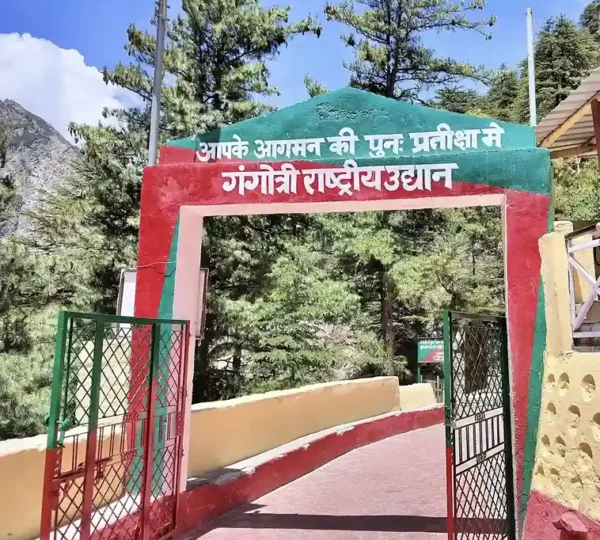
Reflections: Do It Afraid
This Vasukital trek taught me many things—but most of all, that courage isn’t always loud. Sometimes, it’s just the quiet decision to take the next step, even when you’re uncertain. There were moments when I was tired, sore, and genuinely concerned about the terrain ahead. But you do it afraid, and you keep moving.
The Vasukital trek doesn’t offer manicured trails or cozy campsites. It’s raw, unpredictable, and deeply real. It challenges you not just physically, but mentally. And while the views are commanding, it’s the terrain that earns your respect.
Thanks to Mountain Paradise Team
Thanks to Mukesh bhaiya who organized the Vasukital trek and treated us like family. Shivam, Sachin, Pavan, Harish, and Sajjan—their leadership, mountain sense, and calm under pressure carried us through some truly sketchy sections. Whether you were building safe lines over glacial streams or managing rope descents on loose moraine, your presence made the difference.
And to the Porters
Tilak, Himaal, Ramesh, and Lal Bahadur—carrying heavy loads across boulder fields, glacier crossings, and steep ascents while still keeping spirits high is no small feat. You made sure everything—from food to tents to safety—reached where it needed to, every single day.
Without this team, this trek would not have been possible. You turned a demanding route into a shared experience, and we are grateful beyond words.
If you are interested in this Vasukital Trek, go with Mountain Paradise India.
To book your trek, click here.
Or contact on WhatsApp.
Gangotri – Tapovan – Nandanvan – Vasukital
Anurag Goyal, 22-28 June 2025

